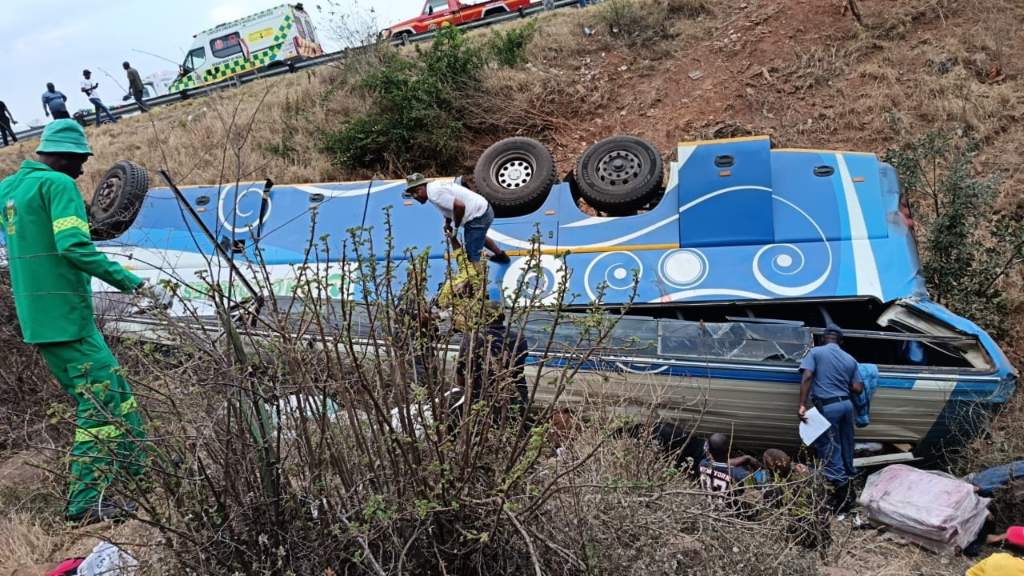
Transport Minister Barbara Creecy said a preliminary probe found the Limpopo bus that killed 43 people was speeding and unroadworthy, with only half its brakes working.
@_ArriveAlive/X
- Preliminary findings in the fatal Limpopo bus crash have revealed that failing brakes and speeding could have led to the fatalities.
- Minister Barbara Creecy has authorised a full investigation into the Limpopo bus and culpable homicide charges may be pursued.
- Authorities will probe the bus company’s maintenance records, weighbridge enforcement failures, and the legality of its roadworthy certificate.
A preliminary investigation into the horrific Limpopo bus crash that claimed the lives of 43 people has revealed that the vehicle was speeding and unroadworthy, with only half of its brakes functioning at the time of the accident.
Transport Minister Barbara Creecy released the findings on Friday.
According to the report, a mechanical inspection found that just five out of 10 brakes on the bus and trailer were in working condition, while one brake on the bus had no braking ability at all.
“None of the four brakes on the trailer were operational, and investigators found evidence of poorly repaired suspension,” Creecy said in a statement.
Authorities believe that excessive speed down a steep mountain pass, combined with the critical brake failures, were the major contributing factors to the tragedy.
READ | Zimbabwe mourns 43 victims of Limpopo bus tragedy – investigations continue
Creecy has authorised traffic officials to investigate and possibly pursue culpable homicide charges against the bus company involved in the devastating crash on the N1 between Makhado and Musina in Limpopo.
The tragedy occurred on Sunday, when a bus owned by DNC Coaches that was carrying 91 passengers, including several children, plunged down a mountain pass. It was also found to be grossly overloaded by 23 passengers, having had a legal seating capacity of just 62.
“It is deeply concerning that this bus and its attached trailer had only five out of ten brakes working,” Creecy said.
She added:
The driver was aware of this deficiency and had adapted his driving style to accommodate the defect, which is simply unacceptable given the risks to passengers.
The report further revealed that the bus was carrying eleven children aged between three and five years old. According to the National Road Traffic Regulations, two children under six are considered one adult passenger — meaning the bus was technically overloaded by 23 persons.
“Investigators also confirmed that the trailer was loaded with baggage and personal belongings, adding extra strain to the already compromised braking system,” Creecy said.
Over and above those killed, 34 people also sustained serious injuries in the crash. Another six suffered minor injuries.
Creecy said:
Eight passengers reportedly refused medical treatment at the scene and left before their details could be recorded.
“The RTMC (Road Traffic Management Corporation) found that weather and road conditions did not contribute to the crash. The N1’s surface, markings and signage were in good condition, and visibility was clear at the time of the accident.”
She said a comprehensive technical reconstruction of the incident was under way and expected to take up to 21 weeks to complete.
“This investigation will examine every aspect of the tragedy from mechanical faults to potential lapses in enforcement at weighbridges where overloading should have been detected,” the minister added.
READ | Limpopo bus crash: Mothers fight for their lives unaware that their babies are dead
She confirmed that authorities would also scrutinise the bus operator’s maintenance and safety compliance.
“We have directed the company to submit full maintenance schedules and service records for the bus involved,” Creecy said.
“Furthermore, our Anti-Corruption Unit will investigate how this vehicle obtained a roadworthy certificate, and whether the testing centre involved acted lawfully.”
The probe would also extend to an assessment of DNC Coaches’ depots operating in South Africa to determine the overall roadworthiness of their fleet.
“Forty-three lives have been lost because of negligence and possible criminal conduct. We owe it to the victims and their families to ensure that justice is served and that such tragedies never happen again.”








